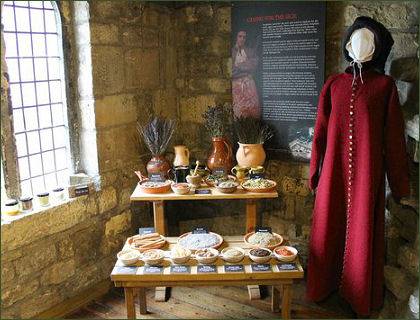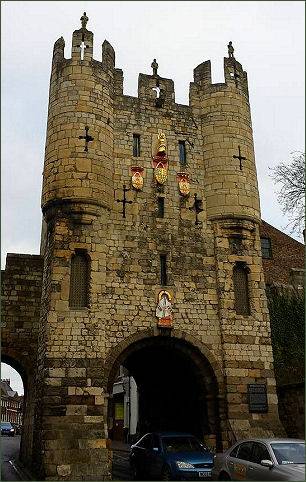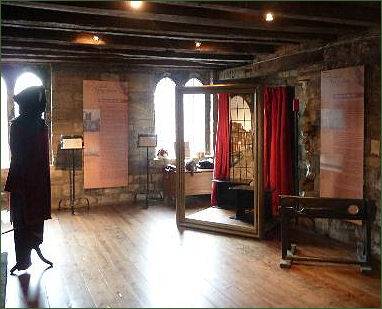Micklegate Bar and the Henry VII Experience
 The oldest parts of York's Micklegate Bar date back to the twelfth century. The name derives from a combination of the Old Norse words 'mykill' (meaning great) and 'gata' (street). In medieval times this entrance to the city was known as "Micklelith".
The oldest parts of York's Micklegate Bar date back to the twelfth century. The name derives from a combination of the Old Norse words 'mykill' (meaning great) and 'gata' (street). In medieval times this entrance to the city was known as "Micklelith".
 The bar incorporates re-used Roman stone and sarcophagi in the outer archway
and side walls.
The bar incorporates re-used Roman stone and sarcophagi in the outer archway
and side walls.
Following the construction of the medieval city walls, Micklegate Bar, the most westerly entrance to the city, became the primary entrance into York. The heavy portcullis and barbican date to the fourteenth century. The gatehouse rises to four stories, the upper two floors contain living quarters. Micklegate Bar is the traditional ceremonial entrance for monarchs visiting the city, who, in a custom dating to King Richard II in 1389, touch the state sword when entering the gate.
The decapitated heads of traitors were once displayed on the bar and left to rot. During the dynastic struggle known to us as the Wars of the Roses, following the Lancastrian victory at the Battle of Wakefield, which was fought on 30 December 1460, the heads of Richard Plantagenet, 3rd Duke of York (father of Kings Edward IV and Richard III) and his seventeen year old second son, Edmund, Earl of Rutland, were displayed on the bar. York's brother-in-law, Richard Neville, 5th Earl of Salisbury, who was captured and executed after the battle, completed the gruesome display. This was done on the orders of the strong willed Lancastrian Queen, Margaret of Anjou whom Shakespeare depicts as saying "Off with his head and set it on York gates; So York may overlook the town of York."
After the Battle of Towton, a decisive Yorkist victory and one of the bloodiest battles ever fought on English soil, King Edward IV entered York in triumph to find the heads of his family still displayed over the gateway. He retaliated by executing major Lancastrian supporters, whose heads replaced his father's and brother's atop the Bar.
Others who suffered this grisly fate included Henry Hotspur Percy (1403) who died at the Battle of Shrewsbury on 21 July 1403, whilst in rebellion against King Henry IV. Henry Scrope, 3rd Baron Scrope of Masham, who was beheaded on 5 August 1415 for his involvement in the Southampton plot against Henry V, and the Catholic Thomas Percy, 7th Earl of Northumberland who was beheaded on 22 August 1572 for rebelling against Elizabeth I's government.
The last heads to be displayed on Micklegate Bar were those of William Connolly and James Mayne an Irish Protestant and Scots Catholic, who fought for Bonnie Prince Charlie during the Jacobite Rebellion in 1746. The Jacobite prisoners were transported from Scotland for trial and execution and held in York Castle Prison. Their heads remained rotting on spikes at Micklegate Bar for eight years until they were finally stolen in 1754 by the Jacobite sympathizer, William Arundel, with the aid of an Irish tailor.
There have been numerous Roman finds in the area of Micklegate, pieces of Roman stone, including a stone coffin, have been integrated into the building, although the actual gatehouse is not on the line of York's Roman walls.
 The Coats of Arms on Micklegate Bar are those of King Edward III and the Lord Mayor of York in 1737. The statues on the top of the bar were carved by R. Ridley in 1950 as replacements for earlier ones.
The Coats of Arms on Micklegate Bar are those of King Edward III and the Lord Mayor of York in 1737. The statues on the top of the bar were carved by R. Ridley in 1950 as replacements for earlier ones.
The interior of Micklegate Bar was repaired between 1716 and 1737, the barbican was removed in 1816 and the building was completely restored in 1952.
In 2014 the Jorvik Group, (which includes the Jorvik Viking Centre), took over the space within Micklegate Bar and created 'The Henry VII Experience'. They also replaced the contents of the Monk Bar and created The Richard III Experience.
Henry VII, who defeated Richard III at the Battle of Bosworth Field in 1485, became the first king of the Tudor dynasty. The museum covers Henry's early years as the Earl of Richmond, an exiled Lancastrian heir to the throne with what was considered by many to possess but a flimsy claim to England's throne. Despite marrying Elizabeth of York to satisfy his Yorkist supporthers, his early reign was made unstable by Yorkist rebellion and pretenders to the throne but he managed to establish one of the most famous of royal dynasties and passed his crown to his son Henry VIII. Henry first visited York within a year of his accession and entered via the customary royal entrance of Micklegate Bar. He was welcomed by the city's sheriffs and aldermen with much pagentry.
The museum also features his impact on the city of York, as it continued to prosper throughout his reign, with interactive experiences and displays dedicated to the life of the Tudor King. One of the exhibitions at the museum depicts life within its stone walls for the ordinary families who once lived there. Another relates the story of the Yorkist victory at the bloody Battle of Towton. .The Tudor camp covers grisly facts about Tudor times written by 'Horrible Histories' author Terry Deary.
Guide to the Walls
| York City Walls | Bootham Bar | Fishergate Bar | Micklegate Bar & the Henry VII Experience |
| Monk Bar & the Richard III Experience |
The Multiangular Tower |
The Red Tower | Walmgate Bar |
Historic buildings in Yorkshire
